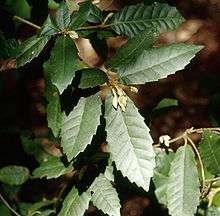Notholithocarpus
| Notholithocarpus | |
|---|---|
 | |
| Foliage | |
| Scientific classification | |
| Kingdom: | Plantae |
| (unranked): | Angiosperms |
| (unranked): | Eudicots |
| (unranked): | Rosids |
| Order: | Fagales |
| Family: | Fagaceae |
| Genus: | Notholithocarpus Manos, Cannon & S.H.Oh |
| Species: | N. densiflorus |
| Binomial name | |
| Notholithocarpus densiflorus (Hook. & Arn.) Manos, Cannon & S.H.Oh | |
| Synonyms | |
| |
Notholithocarpus densiflorus, commonly known as the tanoak or tanbark-oak, is an evergreen tree in the beech family (Fagaceae), native to the western United States, in California as far south as the Transverse Ranges, north to southwest Oregon, and east in the Sierra Nevada. It can reach 40 m (130 ft) tall (though 15–25 m (49–82 ft) is more usual) in the California Coast Ranges, and can have a trunk diameter of 60–190 cm (24–75 in).
Tanbark-oak was recently moved into a new genus, Notholithocarpus (from Lithocarpus), based on multiple lines of evidence.[1] It is most closely related to the north temperate oaks, Quercus, and not as closely related to the Asian tropical stone oaks, Lithocarpus (where it was previously placed), but instead is an example of convergent morphological evolution.

Description
The Notholithocarpus (prev. Lithocarpus) densiflorus leaves are alternate, 7–15 cm (2.8–5.9 in), with toothed margins and a hard, leathery texture, and persist for three to four years. At first they are covered in dense orange-brown scurfy hairs on both sides, but those on the upper surface soon wear off, those on the under surface persisting longer but eventually wearing off too.
The seed is a nut 2–3 cm (0.79–1.18 in) long and 2 cm in diameter, very similar to an oak acorn, but with a very hard, woody nut shell more like a hazel nut. The nut sits in a cup during its 18-month maturation; the outside surface of the cup is rough with short spines. The nuts are produced in clusters of a few together on a single stem. The nut kernel is very bitter, and is inedible for people without extensive leaching, although squirrels eat them.
Tanoak is one of the species most seriously affected by "sudden oak death" (Phytophthora ramorum), with high mortality reported over much of the species' range.[2]
Notholithocarpus densiflorus var. echinoides
Members of populations in interior California (in the northern Sierra Nevada) and the Klamath Mountains into southwest Oregon are smaller, rarely exceeding 3 m (9.8 ft) in height and often shrubby, with smaller leaves, 4–7 cm (1.6–2.8 in) long; these are separated as "dwarf tanoak", Notholithocarpus densiflorus var. echinoides. The variety intergrades with the type in northwest California and southwest Oregon. Tanoak does grow on serpentine soils as a shrub.
Uses
Some California Native Americans prefer this nut to those of many Quercus acorns because it stores well due to the comparatively high tannin content. The Concow tribe call the nut hä’-hä (Konkow language).[3] The Hupa people use the acorns to make meal, from which they would make mush, bread, biscuits, pancakes, and cakes. They also roast the acorns and eat them.[4] Roasted, the seeds can be used as a coffee substitute.[5]
The name tanoak refers to its tannin-rich bark, a type of tanbark, used in the past for tanning leather before the use of modern synthetic tannins. By 1907 the use of tanoak for tannin was subsiding due to the scarcity of large tanoak trees. There weren't enough trees around for a worthwhile economic return. By the early 1960s there were only a few natural tannin operations left in California. The industry was beginning to switch to a synthetic alternative.[6] A mulch made from the leaves of the plant can repel grubs and slugs.[5]
Tanoak tannin has been used as an astringent.[7]
Tanoak is sometimes used as lumber,[8] but isn't currently harvested commercially.
Big tree
Currently the largest known tanoak specimen is on private timberland near the town of Ophir, Oregon. It has a circumference of 26 feet (7.9 m), is about 8.25 feet (2.51 m) in diameter at breast height, and is 121 feet (37 m) tall with an average crown spread of 56 feet (17 m).[9]
References
- ↑ Manos, Paul S.; Cannon, Charles H.; Oh, Sang-Hun (2008). "Phylogenetic relationships and taxonomic status of the paleoendemic Fagaceae of Western North America: recognition of a new genus, Notholithocarpus" (PDF). Madrono 55 (3): 181–190. doi:10.3120/0024-9637-55.3.181.
- ↑ http://cisr.ucr.edu/sudden_oak_death.html Sudden Oak Death at University of California, Riverside, Center for Invasive Species Research
- ↑ Chesnut, Victor King (1902). Plants used by the Indians of Mendocino County, California. Government Printing Office. p. 405. Retrieved 24 August 2012.
- ↑ Merriam, C. Hart 1966 Ethnographic Notes on California Indian Tribes. University of California Archaeological Research Facility, Berkeley (p. 200)
- 1 2 Natural Medicinal Herbs: Home Url = www.naturalmedicinalherbs.net Reference page = Herb latin name: Lithocarpus pachyphylla
- ↑ University of California Oak Woodland Management: Home Url = ucanr.edu Reference page = Does It Make Cents to Process Tanoak to Lumber
- ↑ USDA Forest Service: Home Url = www.na.fs.fed.us Reference page = Lithocarpus densiflorus (Hook. & Arn.) Rehd.
- ↑ "Mendocino Coast Furnituremakers". Mendocino Coast Furnituremakers. Retrieved 18 September 2015.
- ↑ American Forests
External links
![]() Media related to Notholithocarpus densiflorus at Wikimedia Commons
Media related to Notholithocarpus densiflorus at Wikimedia Commons
- Jepson Manual Treatment – Lithocarpus densiflorus
- USDA Plants Profile: Lithocarpus densiflorus
- Flora of North America: Lithocarpus densiflorus
- Lithocarpus densiflorus Photo gallery
- Interactive Distribution Map of Lithocarpus densiflorus
- Forest Service Fire Ecology

| ||||||||||||||||||||||||||||||||||||||||||||